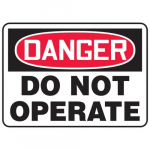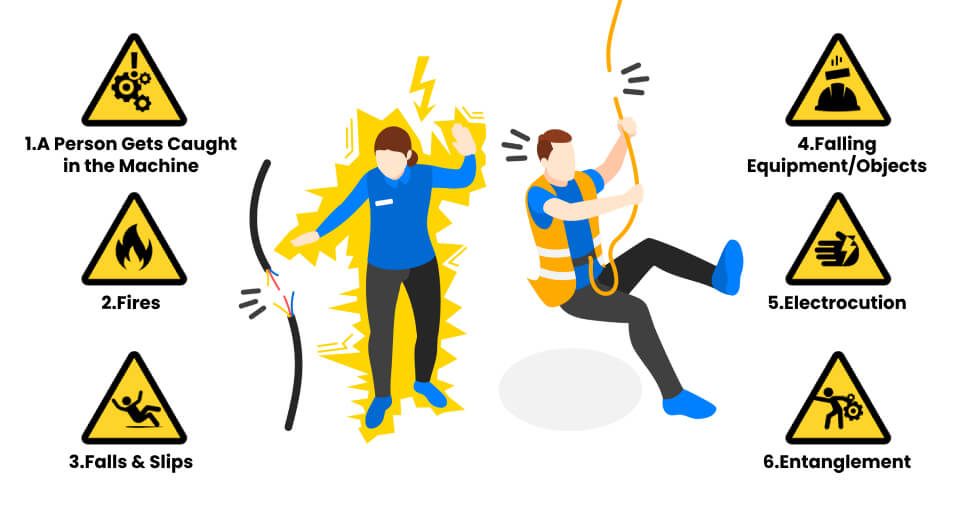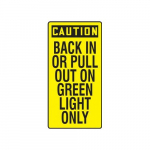
- Show results for
- Share
The Critical Role of Safety in Machine Operation
Resource Description

Contents
- Introduction
- Machine Operation Safety: Definition
- Machine Operation Safety: Rules
- Workplace Accidents: Common Types & Prevention Methods + Products
- Conclusion
Introduction

Nowadays, the use of machinery is integral to productivity and efficiency in many industries. And when using any machine, safety should not be underestimated or overlooked. It must be a #1 priority because the health and life of people depend on it.
In this article, let’s consider what machine operation safety is, what rules are there, and what workplace accidents can occur plus ways of preventing them.
Machine Operation Safety: Definition

Machines often have moving parts, presses, hot surfaces, clamps, as well as sharp edges that pose dangers, and operators must be protected.
Machine operation safety includes methods and/or devices that reduce the risk of workplace injuries or deaths caused by using machines.
Machine Operation Safety: Rules

When it comes to working with machines, there are rules that must be followed. Employees must know these rules and be trained on safety standards regularly.
Here are some general machine operation safety rules:
- Operate machinery only when safeguards are correctly installed and adjusted.
- Never remove machine safeguards.
- Do not use a machine with unauthorized or damaged safeguards.
- Immediately report any issues with machine safeguards to your supervisor.
- Lubricate machine parts without removing the safeguards (wherever possible).
- Remove machine safeguards only after equipment lockout/tagout procedures.
- Avoid creating safety hazards, such as new pinch points, or letting objects fall into the moving parts of the machine.
- Always wear the right personal protective equipment (PPE) and keep loose clothing, jewelry, etc. away from machines.
- Don’t walk away from a machine until all its parts have completely stopped moving.
- Direct any questions or concerns about machine safety to your supervisor.
Workplace Accidents: Common Types & Prevention Methods + Products
Injuries are not uncommon when working with machines. However, they can be avoided thanks to proper training, safeguards, compliance with regulations, as well as awareness of the risks that can happen.
In addition, safety signs will also help maintain safety in workplaces. Pay attention to Accuform - the leader when it comes to facility safety identification solutions. Accuform signs and labels are durable and made of high-quality materials. These products are chosen by numerous customers around the world.
Now, back to our topic. Here are several workplace accidents and ways of their prevention:

1. A Person Gets Caught in the Machine
Reasons:
It can happen if, for example, a piece of worker’s clothing gets in the moving part of the machine.
Prevention:
- Make sure that there are employees who are responsible for machine maintenance and that every moving part that is dangerous for human health and life is safeguarded the right way.
- In addition, employee training is important. Those who aren’t trained can’t operate potentially dangerous machines.
- Wearing the appropriate PPE for the job is a must.
Products:
- Be Careful Signs
- Do Not Operate Signs
- Pinch Point Labels
- Pinch Point Signs
- Scoreboards
- Forklift Signs
- Think Signs
- Danger Signs
- Caution Signs
- Warning Signs
Popular Products
2. Fires
A blast injury is a complex type of physical trauma caused by either direct or indirect exposure to an explosion.
Types of Blast Injuries:
- Primary blast injuries result from the high pressures, or blast overpressure, created by explosions. Examples: blast lung, globe (eye) rupture, concussion.
- Secondary blast injuries happen when flying objects from the explosion injure nearby workers. Examples: eye penetration, closed or open brain injuries.
- Tertiary blast injuries result from strong blast winds as well as pressure gradients that can accelerate the body. Examples: Blunt injuries, bone fractures.
- Quaternary blast injuries result from other explosive products & exposure to toxic substances. Examples: burns, injury or incapacitation from inhaled toxic fumes.
- Quinary blast injuries are the clinical consequences of post-detonation environmental contaminants. Examples: radiation exposure, chemical burns.
Reasons:
Faulty wiring, open flames, damaged gas lines, and combustible chemicals that were mismanaged.
Prevention:
Using OSHA-standard SDSs to facilitate the inspection of all machines containing chemicals.
Products:
Popular Products
3. Falls & Slips
Reasons:
A spill is a common reason for falls if it isn’t cleaned up immediately after it occurs. Other factors that can cause falls or slips include cables that are not secured properly, uneven flooring, weather-related hazards, poor lighting conditions, and more.
Prevention:
If spills can’t be cleaned up right away, then a sign should be placed or a roped-off area should be created. In addition, lighting conditions should be proper, the right footwear should be worn by employees, and if there is a dangerous area, a supervisor must be aware of that.
Products:
- Spill Response Equipment Signs
- Spill Labels
- Fall Protection Signs
- Fall Protection Labels
- Floor Signs
Popular Products
4. Falling Equipment/Objects
Reasons:
The main reasons are inappropriate tools and human error. Other factors include faulty equipment, incorrect safety measures, poor equipment maintenance, unsecured loads, fatigue of employees, etc.
Prevention:
First of all, it is important to identify potential hazards. Then, the following steps should be taken: employees must wear appropriate PPE (e.g. hard hats), nets can be hung below the work area (if possible), and everyone should take breaks so that they are focused, work effectively and safely.
Products:
- Hard Hat Signs
- Work Safely Signs
- Work Safely Stickers
- Ladder Signs
- Ladder Labels
- Scaffold Signs
- Construction Signs
Popular Products
5. Electrocution
Reasons:
Faulty or frayed wiring, improper use of extension cords, water contacting electricity, striking underground cables with tools, incorrectly installed outlets, contact with overhead power lines, lack of grounding, and more.
Prevention:
There should be an electrician or equipment inspection team to make sure that there are no exposed wires, that outlets are safe, etc.
Products:
Popular Products
6. Entanglement
Reasons:
Improper interaction with gears, pulleys, extension cords, rotors, ropes, nets, etc.
Prevention:
Do not wear jewelry, long hair must be tied back, avoid loose clothing, and use the safety gear the right way. In addition, safety guards on all equipment should be installed, employee training on machine operation safety must be conducted on a regular basis, and signs must be used to inform workers about potential dangers.
Products:
Popular Products
Conclusion
Machine operation safety is an important aspect of industrial work environments. By following the necessary rules and complying with standards, employers can create a safer workplace, reduce the risk of accidents, and ensure the well-being of their employees. Regular training, proper use of PPE and safety signs, diligent equipment maintenance, organized workspaces, clear emergency procedures, and adherence to safe operating procedures are all key components of a safe workplace.


























